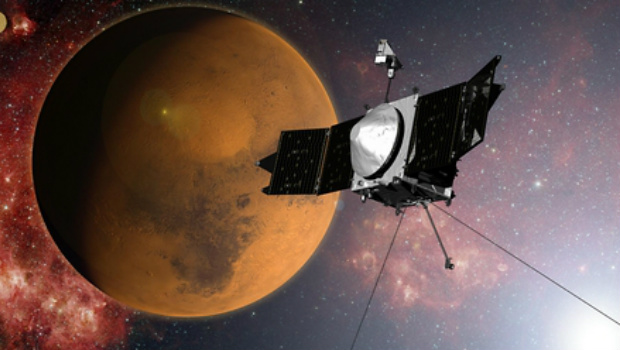After 10 months and 442 million miles, NASA’s MAVEN spacecraft has reached Mars and entered into its orbit.
The first spacecraft dedicated to exploring Mars’ upper atmosphere, scientists hope MAVEN (Mars Atmosphere and Volatile Evolution) will give them clues as to why Mars didn’t hold onto its water and become a lush planet like Earth.
If all goes as planned, MAVEN won’t be the only spacecraft to enter into Mars’ orbit this week.
Another orbiter, this one launched by the Indian Space Research Organisation, is expected to reach Mars and enter its orbit on Wednesday.
As engineers and scientists at NASA’s mission control center waited anxiously for news to come back from its newest Mars-bound spacecraft, Maven took itself out of its traveling trajectory and began a planned burn that lasted a little more than 30 minutes to insert itself into orbit around Mars.
“Here’s a spacecraft hurtling toward Mars and we had no control over it,” said John Grunsfeld, an astronaut and associate administrator of NASA’s Science Mission Directorate. “It’s amazing we have the opportunity to build a spacecraft like MAVEN to learn about Mars. And it worked like clockwork.”
Grunsfeld took questions about the Maven mission in an interview on NASA TV just minutes after it was announced that the spacecraft had successfully entered the Martian orbit.
A NASA spokeswoman, giving commentary during the orbit integration, said the spacecraft, which launched on 18 November, 2013, had worked well throughout its long journey.
“Everything looks fantastic,” she said. “MAVEN has functioned perfectly since launch and we expect her to continue doing so today.”
Moments later, engineers received data from the spacecraft, confirming that it had entered orbit around Mars and had turned off its engines. Cheers and applause erupted in mission control.
“As the first orbiter dedicated to studying Mars’ upper atmosphere, Maven will greatly improve our understanding of the history of the Martian atmosphere, how the climate has changed over time, and how that has influenced the evolution of the surface and the potential habitability of the planet,” said NASA administrator Charles Bolden. “It also will better inform a future mission to send humans to the Red Planet in the 2030s.”
Primary mission
Before beginning its primary scientific mission, Maven is scheduled to begin a six-week test period, in which it will likely make slight adjustments in its orbit and test its instruments and science-mapping commands.
After that phase is completed, it should begin taking measurements of the structure, composition and escape of gases in Mars’ upper atmosphere. MAVEN also will note interactions with the sun and solar wind.
“This was a very big day for MAVEN,” said David Mitchell, Maven project manager, in a statement. “We’re very excited to join the constellation of spacecraft in orbit at Mars and on the surface of the Red Planet. The commissioning phase will keep the operations team busy for the next six weeks, and then we’ll begin, at last, the science phase of the mission. Congratulations to the team for a job well done today.”
Along with two orbiters – Odyssey and the Mars Reconnaissance Orbiter – NASA also has two robotic rovers, Opportunity and Curiosity, at work on the Martian surface.
Grunsfeld noted that the study of Mars is an international effort, as NASA works with international partners on its various robotic explorers. He noted that the Indian Space Research Organization also has a spacecraft closing in on Mars.
Launched in early November, the Indian spacecraft is expected to enter orbit around Mars on Wednesday. Its mission is to study the Martian surface and atmosphere.
The Indian Space Research Organization reported on its website that it is uploading commands for a trajectory correction maneuver and succesfully test fired its main liquid engine in preparation for reaching Mars and slipping into its orbit.
“Our journey to Mars is a worldwide issue,” said Grunsfeld. “This is going to be phenomenal.”
Computerworld








Subscribers 0
Fans 0
Followers 0
Followers